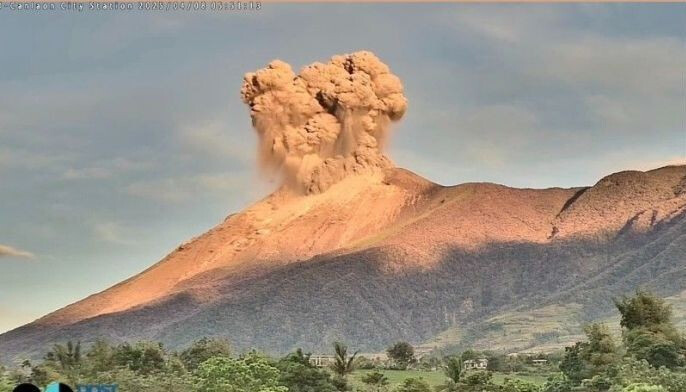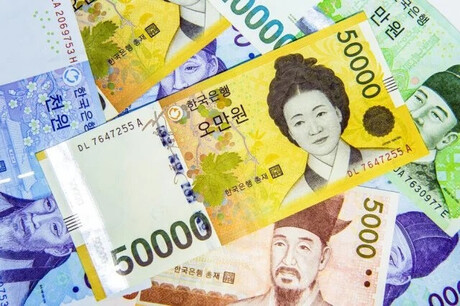
Manila, Philippines – The Kanlaon Volcano, located on Negros Island in the Philippines, emitted 1,044 tons of sulfur dioxide over the past 24 hours, maintaining a high level of vigilance regarding its volcanic activity. The Philippine Institute of Volcanology and Seismology (Phivolcs) announced in its latest report on May 28 that Alert Level 3 for Kanlaon Volcano remains in effect. This level indicates that magma activity has intruded to shallow depths, causing instability and suggesting that a dangerous eruption could occur within weeks.
Sustained Instability: Seismic Activity and Gas Emissions
According to Phivolcs' 24-hour monitoring report, 22 volcanic earthquakes were recorded at Kanlaon Volcano. While this is a slight decrease from the 31 recorded the previous day, it still indicates active internal movement. Volcanic earthquakes, caused by the movement of magma or fluids within the volcano, are an important indicator for predicting eruption potential.
Additionally, the volcano generated a faint plume of smoke approximately 75 meters high drifting northwest. This signifies continuous gas release, and Phivolcs added that the entire volcano remains inflated. Sulfur dioxide (SO2) is a key indicator of volcanic activity; a sharp increase or consistently high levels of emissions can signal rising magma and an impending eruption. In fact, prior to its June 3, 2024 eruption, Kanlaon Volcano averaged 1,273 tons of SO2 emissions per day, which then increased to 3,468 tons. On September 11, 2024, it even recorded a historical high of 11,556 tons. Such gas emission levels directly reflect changes in internal pressure and magma movement within the volcano.
Anticipated Volcanic Hazards and Evacuation of Residents
Phivolcs has warned the public about potential volcanic hazards such as sudden explosive eruptions, lava flows or effusions, ashfall, pyroclastic density currents, rockfalls, and lahars during heavy rainfall. Pyroclastic density currents, in particular, are dangerous flows of high-temperature volcanic gas, ash, and rock fragments that can travel at speeds of hundreds of kilometers per hour, causing catastrophic damage. During Kanlaon Volcano's explosive eruption on April 8, 2025, pyroclastic density currents occurred within 1 km along the south slope of the crater.
Consequently, Phivolcs has recommended the evacuation of residents within a 6 km radius of the Kanlaon summit. This designated Permanent Danger Zone (PDZ) is an area that could be directly impacted by a volcanic eruption. Currently, over 5,000 residents are staying in evacuation centers, and local governments are preparing for further evacuations. During Kanlaon Volcano's explosive eruption on December 9, 2024, ashfall was reported over a wide area west of the volcano, and pyroclastic density currents descended as far as Masolog in La Castellana, approximately 2-3.4 km from the crater.
Furthermore, aviation authorities have prohibited all aircraft from approaching airspace near the volcano. Volcanic ash can cause severe damage to aircraft engines and obscure visibility, posing a serious risk to aviation safety. The Civil Aviation Authority of the Philippines (CAAP) has been issuing notices to airmen (NOTAMs) advising pilots to avoid flying near Kanlaon Volcano since its explosive eruption.
Kanlaon Volcano's Activity History and Ongoing Monitoring
Kanlaon Volcano is one of the most active volcanoes in the Philippines, having experienced several eruptions in recent years. Notably, multiple major eruptions were recorded from 2024 to 2025. The first major eruption occurred on June 3, 2024, followed by explosive eruptions on December 9, 2024, April 8, 2025, and May 13, 2025. These activities are interpreted as a result of magma movement and continuous pressure buildup within the volcano.
Phivolcs is closely monitoring the volcano's continued instability and urges residents to stay informed with the latest updates and adhere to safety protocols. If volcanic activity intensifies further, the alert level could be raised to Level 4, indicating an imminent dangerous magmatic eruption. The ongoing activity of Kanlaon Volcano demands constant vigilance from Philippine authorities and local residents, reiterating the importance of thorough preparation and prompt response.
[Copyright (c) Global Economic Times. All Rights Reserved.]




























